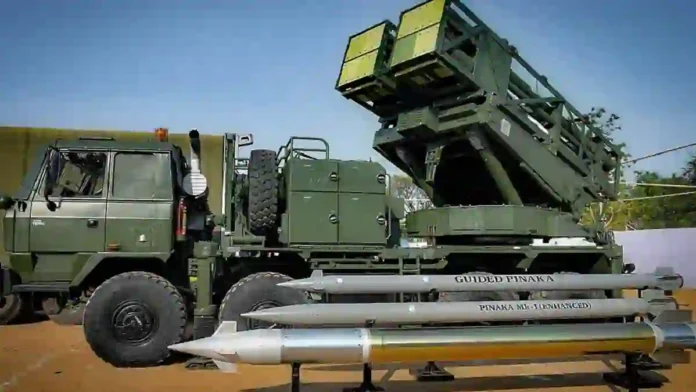The Pinaka Multi-Barrel Rocket Launcher System, a product of Indian indigenous defence technology, has recently achieved a significant milestone with the successful conclusion of trials for its Extended Range (ER) version. The ER Pinaka substantially enhances the Indian Army’s artillery capabilities, providing both increased range and precision for battlefield operations.
Originally, the Pinaka rockets were capable of striking targets up to 37km away, but the latest advancements have doubled this range to approximately 75km. This enhanced reach enables the system to support deep-fire missions and long-range suppression of enemy positions, substantially expanding operational flexibility.
Read- India’s Nuclear Submarine Program Races Against Time With Pakistan Seizing The Lead
Accuracy has also seen a quantum leap: the new GPS-guided rockets, supported by an onboard computer, are capable of striking within a 25-metre radius of their intended target. This precision, combined with a comparatively large warhead, renders the ER Pinaka extremely lethal against both concentrated and dispersed adversary formations.
The navigation and targeting systems constitute significant upgrades. The ER Pinaka is equipped with both a Global Positioning System (GPS) and an Inertial Navigation System (INS). Together, these systems allow for programmable trajectories and targets prior to launch. In the event that the rocket strays from its set course, the onboard computer uses GPS to correct its path.
Should GPS be unavailable due to jamming or interference, the INS ensures the projectile still reaches its designated target, maintaining mission reliability under electronic warfare conditions.
Each Pinaka battery consists of six launchers, and every launcher is fitted with 12 tubes, allowing for a total salvo of 72 rockets per battery. These can be launched in a rapid timeframe of just 44 seconds, essentially saturating a designated enemy area of up to 1,000,800 square metres in a single strike. Post-firing, the highly mobile nature of each launcher allows for rapid displacement and repositioning, enhancing survivability and sustaining operational tempo.
Read- Trump’s Threats Unlikely To Break India-Russia Ties: NSA Doval Visits Moscow
Read- Pakistan’s Army Chief Signals Multi-Front Threat To India With Focus On Eastern Front
Ammunition has also been diversified and modernised. The Indian Army has inducted Area Denial Munition (ADM) Type-1 (DPICM) and High Explosive Pre-Fragmented (HEPF) Mk-1 (Enhanced) rockets for the Pinaka system. These munitions provide specialised effects such as fragmentation and area saturation, making the Pinaka one of the most versatile and effective multiple launch rocket systems in service.
In terms of force structure, the Indian Army is preparing for a substantial increase in Pinaka-equipped units. At present, there are four regiments operational, but plans are underway to expand this figure to ten regiments within the next two years.
This expansion is being achieved by converting existing 120mm mortar light regiments into Pinaka regiments, rather than constituting entirely new units. Two regiments have already undergone this conversion, with two more scheduled for this year, expediting the process and optimising the use of existing personnel and assets.
Historically, the Indian Army’s rocket artillery relied on Russian systems such as the Grad and Smerch, but the homegrown Pinaka system has markedly improved indigenous capabilities, reducing dependence on foreign suppliers and increasing battlefield self-reliance.
With the extended-range variant now entering service, the Pinaka MLRS stands as a testament to India’s growing technological prowess in indigenous defence systems and a formidable asset within the Army’s long-range strike arsenal.
Based On India Today Report
Agency




